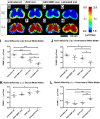Bone marrow transplantation augments the effect of brain- and spinal cord-directed adeno-associated virus 2/5 gene therapy by altering inflammation in the murine model of globoid-cell leukodystrophy
- PMID: 21734286
- PMCID: PMC3348856
- DOI: 10.1523/JNEUROSCI.1802-11.2011
Bone marrow transplantation augments the effect of brain- and spinal cord-directed adeno-associated virus 2/5 gene therapy by altering inflammation in the murine model of globoid-cell leukodystrophy
Abstract
Globoid-cell leukodystrophy (GLD) is an inherited demyelinating disease caused by the deficiency of the lysosomal enzyme galactosylceramidase (GALC). A previous study in the murine model of GLD (twitcher) demonstrated a dramatic synergy between CNS-directed adeno-associated virus 2/5 (AAV2/5) gene therapy and myeloreductive bone marrow transplantation (BMT). However, the mechanism by which these two disparate therapeutic approaches synergize is not clear. In addition, the therapeutic efficacy may have been limited since the CNS-directed gene therapy was restricted to the forebrain and thalamus. In the current study, intrathecal and intracerebellar injections were added to the therapeutic regimen and the mechanism of synergy between BMT and gene therapy was determined. Although AAV2/5 alone provided supraphysiological levels of GALC activity and reduced psychosine levels in both the brain and spinal cord, it significantly increased CNS inflammation. Bone marrow transplantation alone provided essentially no GALC activity to the CNS and did not reduce psychosine levels. When AAV2/5 is combined with BMT, there are sustained improvements in motor function and the median life span is increased to 123 d (range, 92-282 d) compared with 41 d in the untreated twitcher mice. Interestingly, addition of BMT virtually eliminates both the disease and AAV2/5-associated inflammatory response. These data suggest that the efficacy of AAV2/5-mediated gene therapy is limited by the associated inflammatory response and BMT synergizes with AAV2/5 by modulating inflammation.
Figures











Similar articles
-
CNS-targeted AAV5 gene transfer results in global dispersal of vector and prevention of morphological and function deterioration in CNS of globoid cell leukodystrophy mouse model.Mol Genet Metab. 2011 Aug;103(4):367-77. doi: 10.1016/j.ymgme.2011.05.005. Epub 2011 May 12. Mol Genet Metab. 2011. PMID: 21620749
-
Central nervous system-directed AAV2/5-mediated gene therapy synergizes with bone marrow transplantation in the murine model of globoid-cell leukodystrophy.Mol Ther. 2007 Jan;15(1):44-52. doi: 10.1038/sj.mt.6300026. Mol Ther. 2007. PMID: 17164774
-
Bone marrow transplantation increases efficacy of central nervous system-directed enzyme replacement therapy in the murine model of globoid cell leukodystrophy.Mol Genet Metab. 2012 Sep;107(1-2):186-96. doi: 10.1016/j.ymgme.2012.05.021. Epub 2012 Jun 1. Mol Genet Metab. 2012. PMID: 22704480 Free PMC article.
-
Treatment for Krabbe's disease: Finding the combination.J Neurosci Res. 2016 Nov;94(11):1126-37. doi: 10.1002/jnr.23822. J Neurosci Res. 2016. PMID: 27638598 Free PMC article. Review.
-
The twitcher mouse: a model for Krabbe disease and for experimental therapies.Brain Pathol. 1995 Jul;5(3):249-58. doi: 10.1111/j.1750-3639.1995.tb00601.x. Brain Pathol. 1995. PMID: 8520724 Review.
Cited by
-
Preclinical studies in Krabbe disease: A model for the investigation of novel combination therapies for lysosomal storage diseases.Mol Ther. 2023 Jan 4;31(1):7-23. doi: 10.1016/j.ymthe.2022.09.017. Epub 2022 Oct 4. Mol Ther. 2023. PMID: 36196048 Free PMC article. Review.
-
Krabbe Disease: Prospects of Finding a Cure Using AAV Gene Therapy.Front Med (Lausanne). 2021 Nov 11;8:760236. doi: 10.3389/fmed.2021.760236. eCollection 2021. Front Med (Lausanne). 2021. PMID: 34869463 Free PMC article. Review.
-
AAVrh10 Gene Therapy Ameliorates Central and Peripheral Nervous System Disease in Canine Globoid Cell Leukodystrophy (Krabbe Disease).Hum Gene Ther. 2018 Jul;29(7):785-801. doi: 10.1089/hum.2017.151. Epub 2018 Mar 14. Hum Gene Ther. 2018. PMID: 29316812 Free PMC article.
-
Experimental therapies in the murine model of globoid cell leukodystrophy.Pediatr Neurol. 2014 Nov;51(5):600-6. doi: 10.1016/j.pediatrneurol.2014.08.003. Epub 2014 Aug 8. Pediatr Neurol. 2014. PMID: 25240259 Free PMC article. Review.
-
Macrophages Expressing GALC Improve Peripheral Krabbe Disease by a Mechanism Independent of Cross-Correction.Neuron. 2020 Jul 8;107(1):65-81.e9. doi: 10.1016/j.neuron.2020.03.031. Epub 2020 May 5. Neuron. 2020. PMID: 32375064 Free PMC article.
References
-
- Arnett HA, Mason J, Marino M, Suzuki K, Matsushima GK, Ting JP. TNF alpha promotes proliferation of oligodendrocyte progenitors and remyelination. Nat Neurosci. 2001;4:1116–1122. - PubMed
-
- Biswas S, LeVine SM. Substrate-reduction therapy enhances the benefits of bone marrow transplantation in young mice with globoid cell leukodystrophy. Pediatr Res. 2002;51:40–47. - PubMed
-
- Biswas S, Biesiada H, Williams TD, LeVine SM. Substrate reduction intervention by l-cycloserine in twitcher mice (globoid cell leukodystrophy) on a B6;CAST/Ei background. Neurosci Lett. 2003;347:33–36. - PubMed
-
- Bruscia EM, Ziegler EC, Price JE, Weiner S, Egan ME, Krause DS. Engraftment of donor-derived epithelial cells in multiple organs following bone marrow transplantation into newborn mice. Stem Cells. 2006;24:2299–2308. - PubMed
Publication types
MeSH terms
Substances
Grants and funding
- R01 NS 052632/NS/NINDS NIH HHS/United States
- P30 NS057105/NS/NINDS NIH HHS/United States
- R01 AG031675/AG/NIA NIH HHS/United States
- HD02528/HD/NICHD NIH HHS/United States
- R01 NS 054194/NS/NINDS NIH HHS/United States
- R01 NS054194/NS/NINDS NIH HHS/United States
- R01 AG31675/AG/NIA NIH HHS/United States
- P01 NS 059560/NS/NINDS NIH HHS/United States
- R01 NS 047592/NS/NINDS NIH HHS/United States
- R01 NS047592/NS/NINDS NIH HHS/United States
- R01 HD055461/HD/NICHD NIH HHS/United States
- P30 HD002528/HD/NICHD NIH HHS/United States
- P01 NS059560/NS/NINDS NIH HHS/United States
- R01 NS052632/NS/NINDS NIH HHS/United States
LinkOut - more resources
Full Text Sources
Other Literature Sources
Medical
